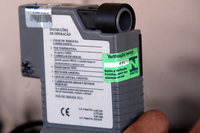








A breathalyzer is a device for estimating blood alcohol content (BAC) from a breath sample. Breathalyzer is the brand name for the instrument developed by inventor Robert Frank Borkenstein.It was registered as a trademark on May 13, 1958, and is active as of 2014 but the word has become a generic trademark.
In 1931 the first practical roadside breath-testing device was the drunkometer developed by Rolla Neil Harger of the Indiana University School of Medicine. The drunkometer collected a motorist's breath sample directly into a balloon inside the machine.The breath sample was then pumped through an acidified potassium permanganate solution. If there was alcohol in the breath sample, the solution changed color. The greater the color change, the more alcohol there was present in the breath. The drunkometer was manufactured and sold by Stephenson Corporation of Red Bank, New Jersey.
In 1954 Robert Frank Borkenstein (1912–2002), a captain with the Indiana State Police and later a professor at Indiana University Bloomington. His Breathalyzer used chemical oxidation and photometry to determine alcohol concentrations. Subsequent breath analyzers have converted primarily to infrared spectroscopy. The invention of the Breathalyzer provided law enforcement with a non-invasive test providing immediate results to determine an individual's breath alcohol concentration at the time of testing.
In 1967 in Britain, Tom Parry Jones developed and marketed the first electronic breathalyser. He established Lion Laboratories in Cardiff with his colleague, electrical engineer Bill Dulcie.The Road Safety Act 1967 introduced the first legally enforceable maximum blood alcohol level for drivers in the UK, above which it became an offence to be in charge of a motor vehicle; and introduced the roadside breathalyser, made available to police forces across the country.In 1979, Lion Laboratories' version of the breathalyser, known as the Alcolyser and incorporating crystal-filled tubes that changed colour above a certain level of alcohol in the breath, was approved for police use. Lion Laboratories won the Queen's Award for Technological Achievement for the product in 1980, and it began to be marketed worldwide.The Alcolyser was superseded by the Lion Intoximeter 3000 in 1983, and later by the Lion Alcolmeter and Lion Intoxilyser.These later models used a fuel cell alcohol sensor rather than crystals, providing a more reliable curbside test and removing the need for blood or urine samples to be taken at a police station. In 1991, Lion Laboratories was sold to the American company MPD, Inc.